Compact Eight-Element MIMO Antenna with Reduced Mutual Coupling and Beam-Scanning Performance
Abstract
1. Introduction
2. Design and Working Principle
2.1. Geometry of Antenna
2.2. Working Principle
3. Mutual Coupling Effects
3.1. Current Distribution
3.2. S-Parameter
3.3. Envelope Correlation Coefficient and Diversity Gain
3.4. Efficiency and Peak Gain
3.5. Radiation Patterns
4. Beamscanning Performance
5. Conclusions
Author Contributions
Funding
Institutional Review Board Statement
Informed Consent Statement
Data Availability Statement
Conflicts of Interest
References
- Liu, B.; Da, Y.; Chen, X.; Kishk, A.A. Hybrid decoupling structure based on neutralization and partition schemes for compact large-scale base station arrays. IEEE Antennas Wirel. Propag. Lett. 2021, 21, 267–271. [Google Scholar] [CrossRef]
- Yang, G.; Zhang, Y.; Zhang, S. Wide-band and wide-angle scanning phased array antenna for mobile communication system. IEEE Open J. Antennas Propag. 2021, 2, 203–212. [Google Scholar] [CrossRef]
- Valavan, S.; Tran, D.; Yarovoy, A.; Roederer, A. Planar dual-band wide-scan phased array in X-band. IEEE Trans. Antennas Propag. 2014, 62, 5370–5375. [Google Scholar] [CrossRef]
- Sun, B.F.; Ding, X.; Cheng, Y.F.; Shao, W. 2-D wide-angle scanning phased array with hybrid patch mode technique. IEEE Antennas Wirel. Propag. Lett. 2020, 19, 700–704. [Google Scholar] [CrossRef]
- Hong, W.; Baek, K.H.; Lee, Y.; Kim, Y.; Ko, S.T. Study and prototyping of practically large-scale mmWave antenna systems for 5G cellular devices. IEEE Commun. Mag. 2014, 52, 63–69. [Google Scholar] [CrossRef]
- Cheng, Y.J.; Fan, Y. Millimeter-wave miniaturized substrate integrated multibeam antenna. IEEE Trans. Antennas Propag. 2011, 59, 4840–4844. [Google Scholar] [CrossRef]
- Pajusco, P.; Malhouroux-Gaffet, N.; El Zein, G. Comprehensive characterization of the double directional UWB residential indoor channel. IEEE Trans. Antennas Propag. 2015, 63, 1129–1139. [Google Scholar] [CrossRef]
- He, R.; Ai, B.; Stüber, G.L.; Wang, G.; Zhong, Z. Geometrical-based modeling for millimeter-wave MIMO mobile-to-mobile channels. IEEE Trans. Veh. Technol. 2017, 67, 2848–2863. [Google Scholar] [CrossRef]
- Chen, X.; Zhang, S.; Li, Q. A review of mutual coupling in MIMO systems. IEEE Access 2018, 6, 24706–24719. [Google Scholar] [CrossRef]
- Nadeem, I.; Choi, D.Y. Study on mutual coupling reduction technique for MIMO antennas. IEEE Access 2018, 7, 563–586. [Google Scholar] [CrossRef]
- Qu, S.W.; He, D.J.; Xia, M.Y.; Nie, Z.P.; Chan, C.H. High-efficiency periodic sparse patch array based on mutual coupling. IEEE Antennas Wirel. Propag. Lett. 2011, 10, 1317–1320. [Google Scholar]
- Pozar, D. Analysis of finite phased arrays of printed dipoles. IEEE Trans. Antennas Propag. 1985, 33, 1045–1053. [Google Scholar] [CrossRef]
- Pozar, D.M. The active element pattern. IEEE Trans. Antennas Propag. 1994, 42, 1176–1178. [Google Scholar] [CrossRef]
- Qu, S.W.; Chan, C.H.; Xia, M.Y.; Nie, Z. High-efficiency periodic sparse microstrip array based on mutual coupling. IEEE Trans. Antennas Propag. 2012, 61, 1963–1970. [Google Scholar] [CrossRef]
- Dandekar, K.R.; Ling, H.; Xu, G. Experimental study of mutual coupling compensation in smart antenna applications. IEEE Trans. Wirel. Commun. 2002, 1, 480–487. [Google Scholar] [CrossRef]
- Habashi, A.; Nourinia, J.; Ghobadi, C. A rectangular defected ground structure (DGS) for reduction of mutual coupling between closely-spaced microstrip antennas. In Proceedings of the 20th Iranian Conference on Electrical Engineering (ICEE2012), Tehran, Iran, 15–17 May 2012; pp. 1347–1350. [Google Scholar]
- Bait-Suwailam, M.M.; Siddiqui, O.F.; Ramahi, O.M. Mutual coupling reduction between microstrip patch antennas using slotted-complementary split-ring resonators. IEEE Antennas Wirel. Propag. Lett. 2010, 9, 876–878. [Google Scholar] [CrossRef]
- Habashi, A.; Nourinia, J.; Ghobadi, C. Mutual coupling reduction between very closely spaced patch antennas using low-profile folded split-ring resonators (FSRRs). IEEE Antennas Wirel. Propag. Lett. 2011, 10, 862–865. [Google Scholar] [CrossRef]
- Hao, Y.; Paini, C. Isolation enhancement of anisotropic UC-PBG microstrip diplexer patch antenna. IEEE Antennas Wirel. Propag. Lett. 2002, 1, 135–137. [Google Scholar] [CrossRef]
- Yang, F.; Rahmat-Samii, Y. Reflection phase characterizations of the EBG ground plane for low profile wire antenna applications. IEEE Trans. Antennas Propag. 2003, 51, 2691–2703. [Google Scholar] [CrossRef]
- Rajo-Iglesias, E.; Quevedo-Teruel, O.; Inclan-Sanchez, L. Mutual coupling reduction in patch antenna arrays by using a planar EBG structure and a multilayer dielectric substrate. IEEE Trans. Antennas Propag. 2008, 56, 1648–1655. [Google Scholar] [CrossRef]
- Yang, X.M.; Liu, X.G.; Zhou, X.Y.; Cui, T.J. Reduction of mutual coupling between closely packed patch antennas using waveguided metamaterials. IEEE Antennas Wirel. Propag. Lett. 2012, 11, 389–391. [Google Scholar] [CrossRef]
- Alsath, M.G.N.; Kanagasabai, M.; Balasubramanian, B. Implementation of slotted meander-line resonators for isolation enhancement in microstrip patch antenna arrays. IEEE Antennas Wirel. Propag. Lett. 2012, 12, 15–18. [Google Scholar] [CrossRef]
- Cheng, Y.F.; Ding, X.; Shao, W.; Wang, B.Z. Reduction of mutual coupling between patch antennas using a polarization-conversion isolator. IEEE Antennas Wirel. Propag. Lett. 2016, 16, 1257–1260. [Google Scholar] [CrossRef]
- Zhang, S.; Pedersen, G.F. Mutual coupling reduction for UWB MIMO antennas with a wideband neutralization line. IEEE Antennas Wirel. Propag. Lett. 2015, 15, 166–169. [Google Scholar] [CrossRef]
- Saleh, A.M.; Nagim, T.A.; Abd-Alhameed, R.A.; Noras, J.M.; See, C.H. Mutual coupling reduction of dual-band uni-planar MIMO system using neutralization line technique. Appl. Comput. Electromagn. Soc. J. (ACES) 2020, 35, 176–186. [Google Scholar]
- Luo, S.; Li, Y.; Xia, Y.; Zhang, L. A low mutual coupling antenna array with gain enhancement using metamaterial loading and neutralization line structure. Appl. Comput. Electromagn. Soc. J. (ACES) 2019, 34, 411–418. [Google Scholar]
- Zhao, L.; Wu, K.L. A dual-band coupled resonator decoupling network for two coupled antennas. IEEE Trans. Antennas Propag. 2015, 63, 2843–2850. [Google Scholar] [CrossRef]
- Ahmad, A.; Choi, D.y.; Ullah, S. A compact two elements MIMO antenna for 5G communication. Sci. Rep. 2022, 12, 3608. [Google Scholar] [CrossRef]
- Zhao, L.; Liu, F.; Shen, X.; Jing, G.; Cai, Y.M.; Li, Y. A high-pass antenna interference cancellation chip for mutual coupling reduction of antennas in contiguous frequency bands. IEEE Access 2018, 6, 38097–38105. [Google Scholar] [CrossRef]
- Chi, G.; Li, B.; Qi, D. Dual-band printed diversity antenna for 2.4/5.2-GHz WLAN application. Microw. Opt. Technol. Lett. 2005, 45, 561–563. [Google Scholar] [CrossRef]
- Wu, T.Y.; Fang, S.T.; Wong, K.L. Printed diversity monopole antenna for WLAN operation. Electron. Lett. 2002, 38, 1. [Google Scholar] [CrossRef]
- Ding, Y.; Du, Z.; Gong, K.; Feng, Z. A novel dual-band printed diversity antenna for mobile terminals. IEEE Trans. Antennas Propag. 2007, 55, 2088–2096. [Google Scholar] [CrossRef]
- Wang, X.; Du, Z.; Gong, K. A compact wideband planar diversity antenna covering UMTS and 2.4 GHz WLAN bands. IEEE Antennas Wirel. Propag. Lett. 2008, 7, 588–591. [Google Scholar] [CrossRef]
- Karaboikis, M.; Soras, C.; Tsachtsiris, G.; Makios, V. Compact dual-printed inverted-F antenna diversity systems for portable wireless devices. IEEE Antennas Wirel. Propag. Lett. 2004, 3, 9–14. [Google Scholar] [CrossRef]
- Balanis, C.A. Antenna Theory, Analysis and Design, 3rd ed.; John Wiley & Sons. Inc. Publication: New York, NY, USA, 2005. [Google Scholar]
- OuYang, J.; Yang, F.; Wang, Z. Reducing mutual coupling of closely spaced microstrip MIMO antennas for WLAN application. IEEE Antennas Wirel. Propag. Lett. 2011, 10, 310–313. [Google Scholar] [CrossRef]
- Chen, X.; Abdullah, M.; Li, Q.; Li, J.; Zhang, A.; Svensson, T. Characterizations of mutual coupling effects on switch-based phased array antennas for 5G millimeter-wave mobile communications. IEEE Access 2019, 7, 31376–31384. [Google Scholar] [CrossRef]
- Zhou, I.; Ramírez, G.A.; Montero, L.; Blanch, S.; Romeu, J.; Jofre, L. Three-dimensional beamsteering low-complexity reconfigurable multilevel antenna. IEEE Antennas Wirel. Propag. Lett. 2020, 19, 1017–1021. [Google Scholar] [CrossRef]
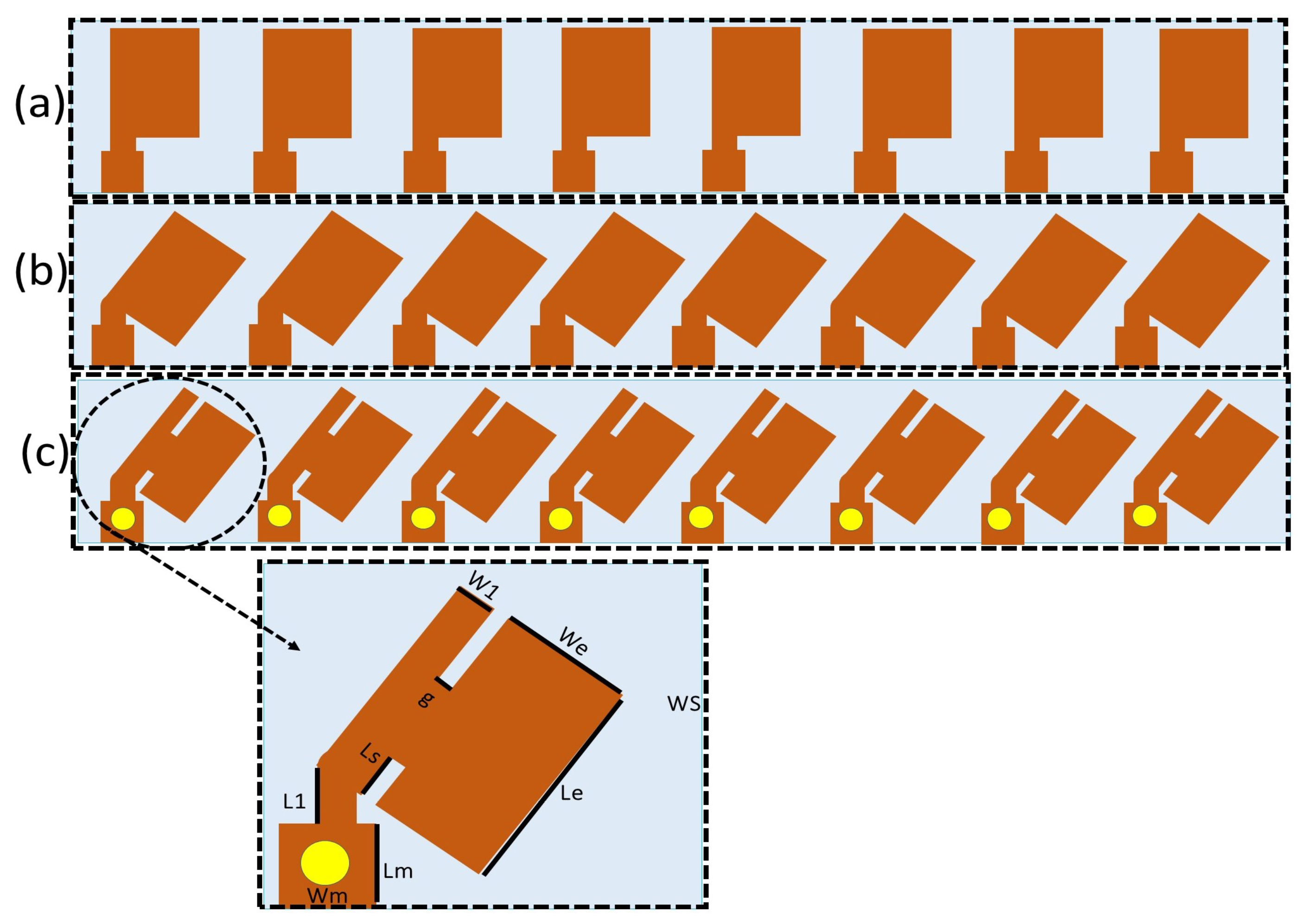
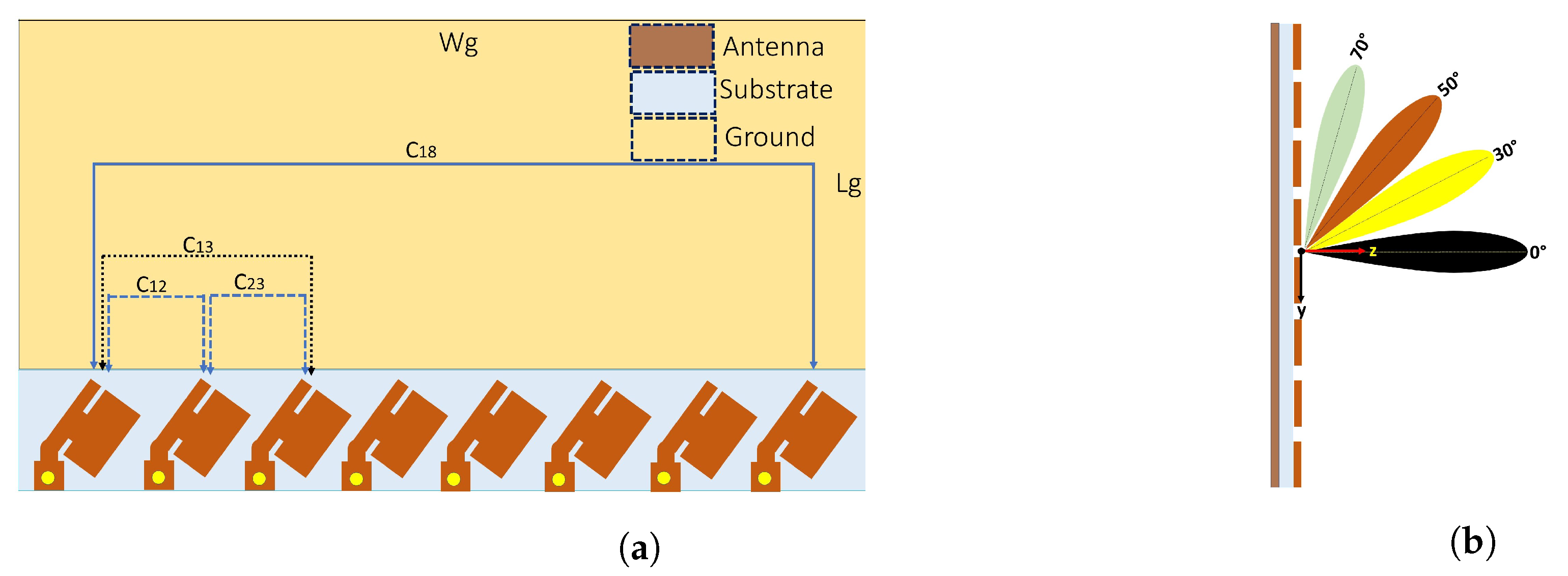
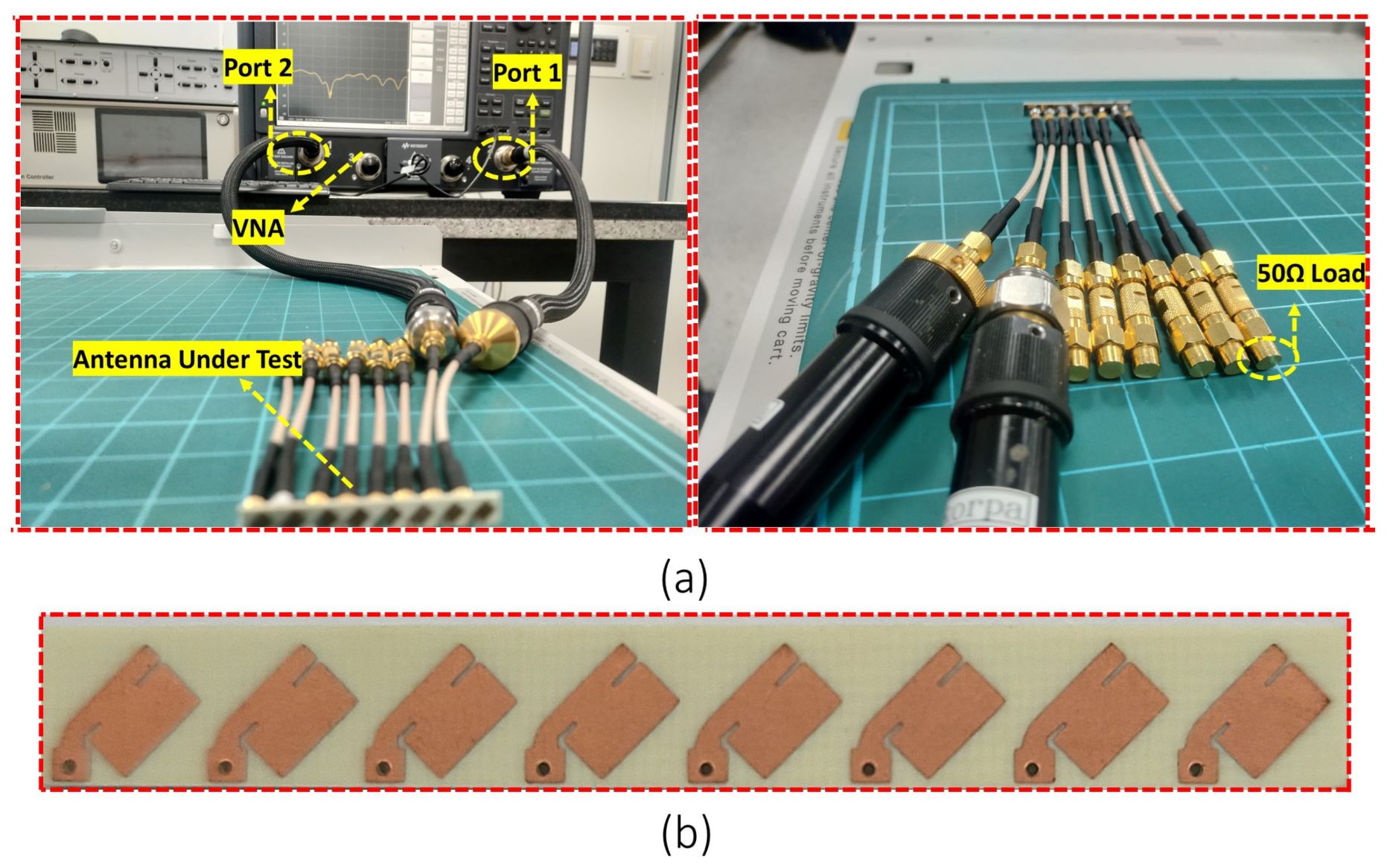

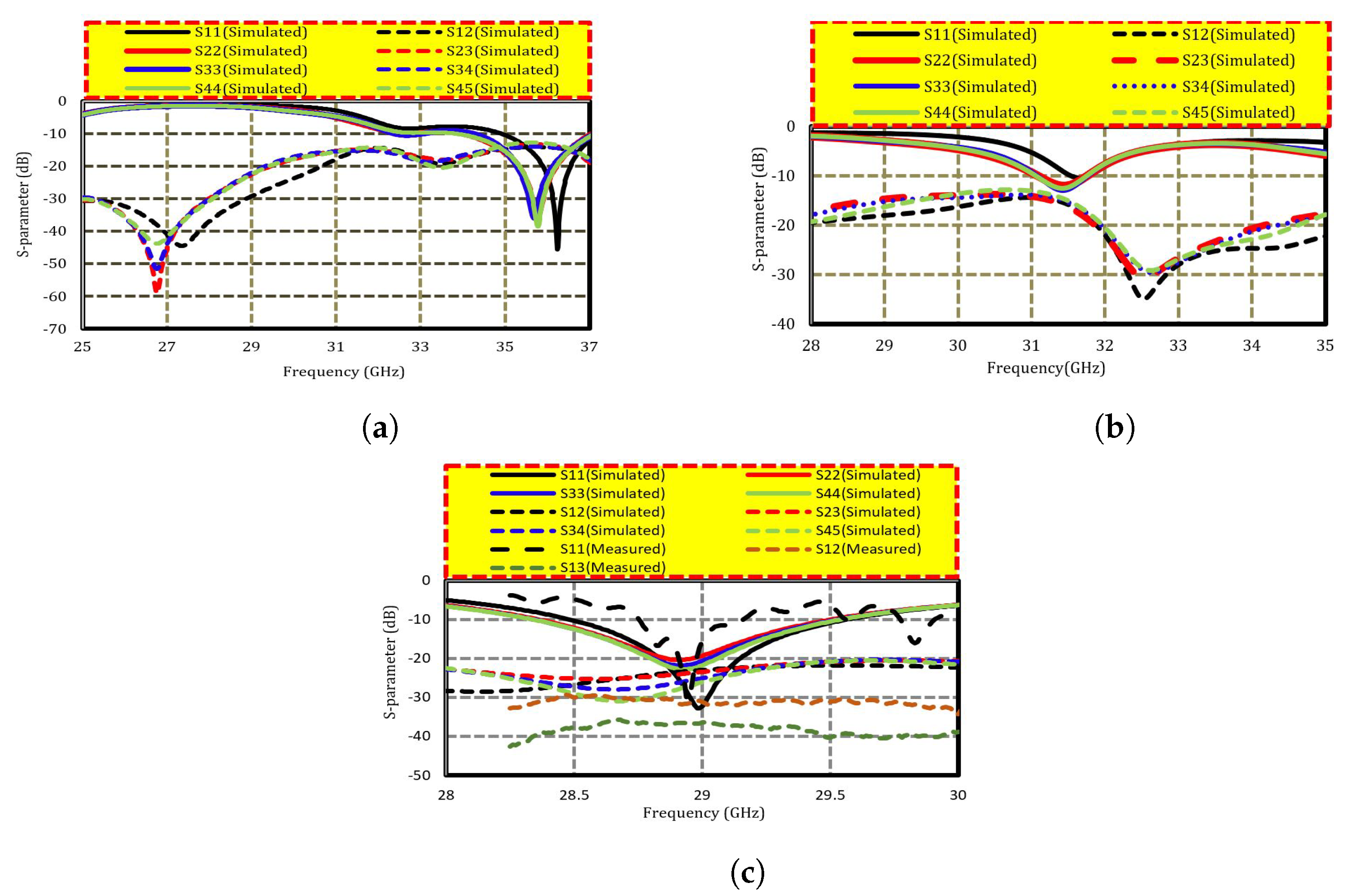
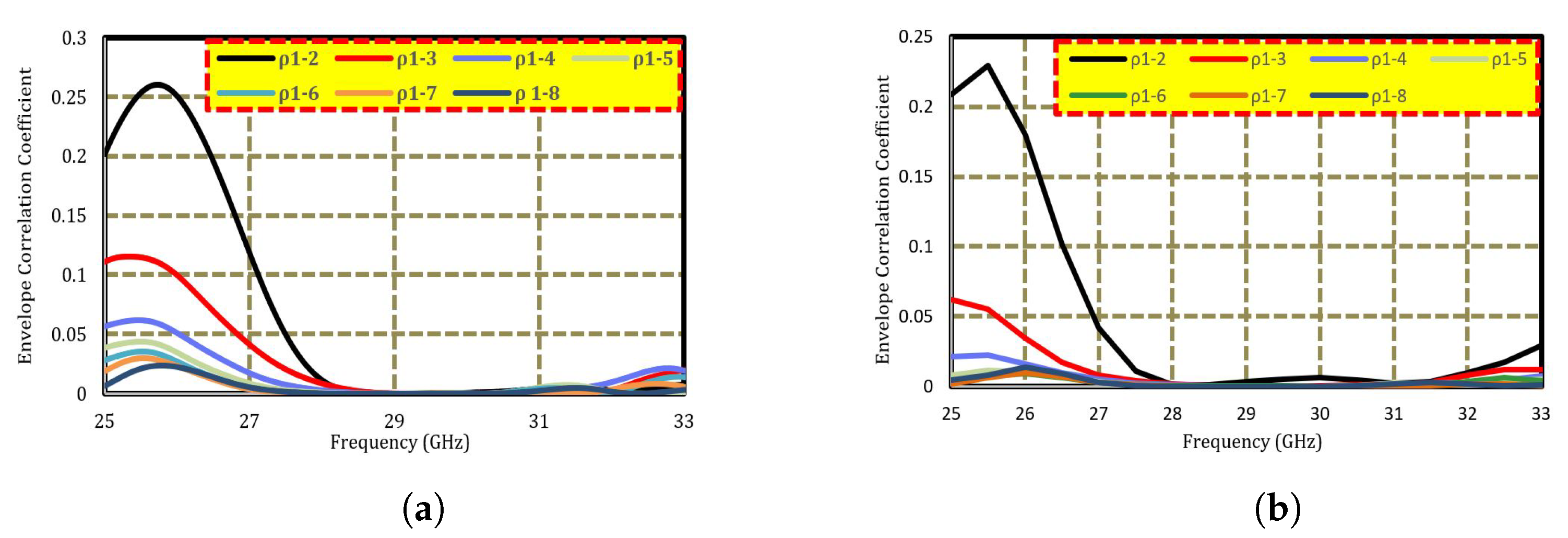
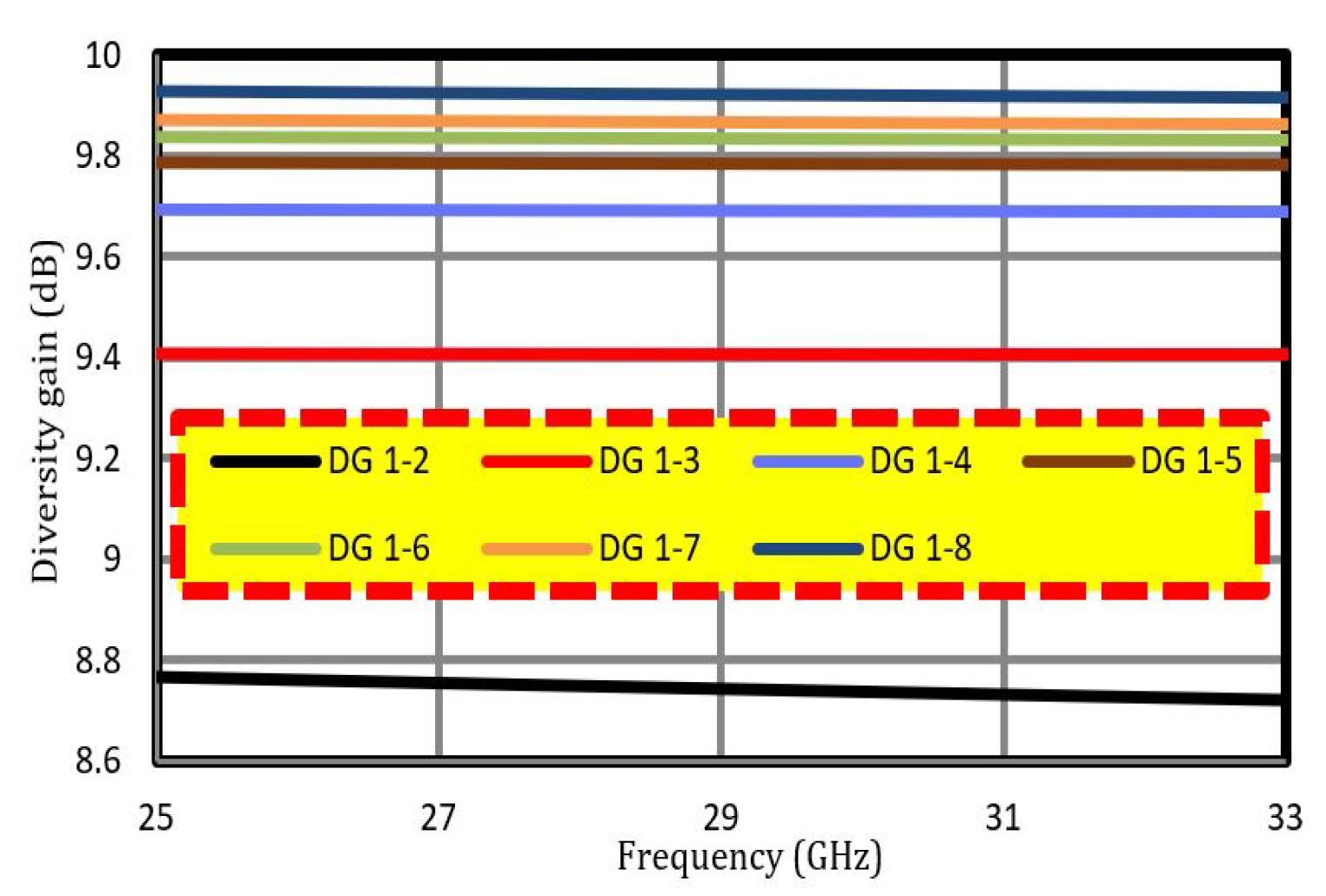
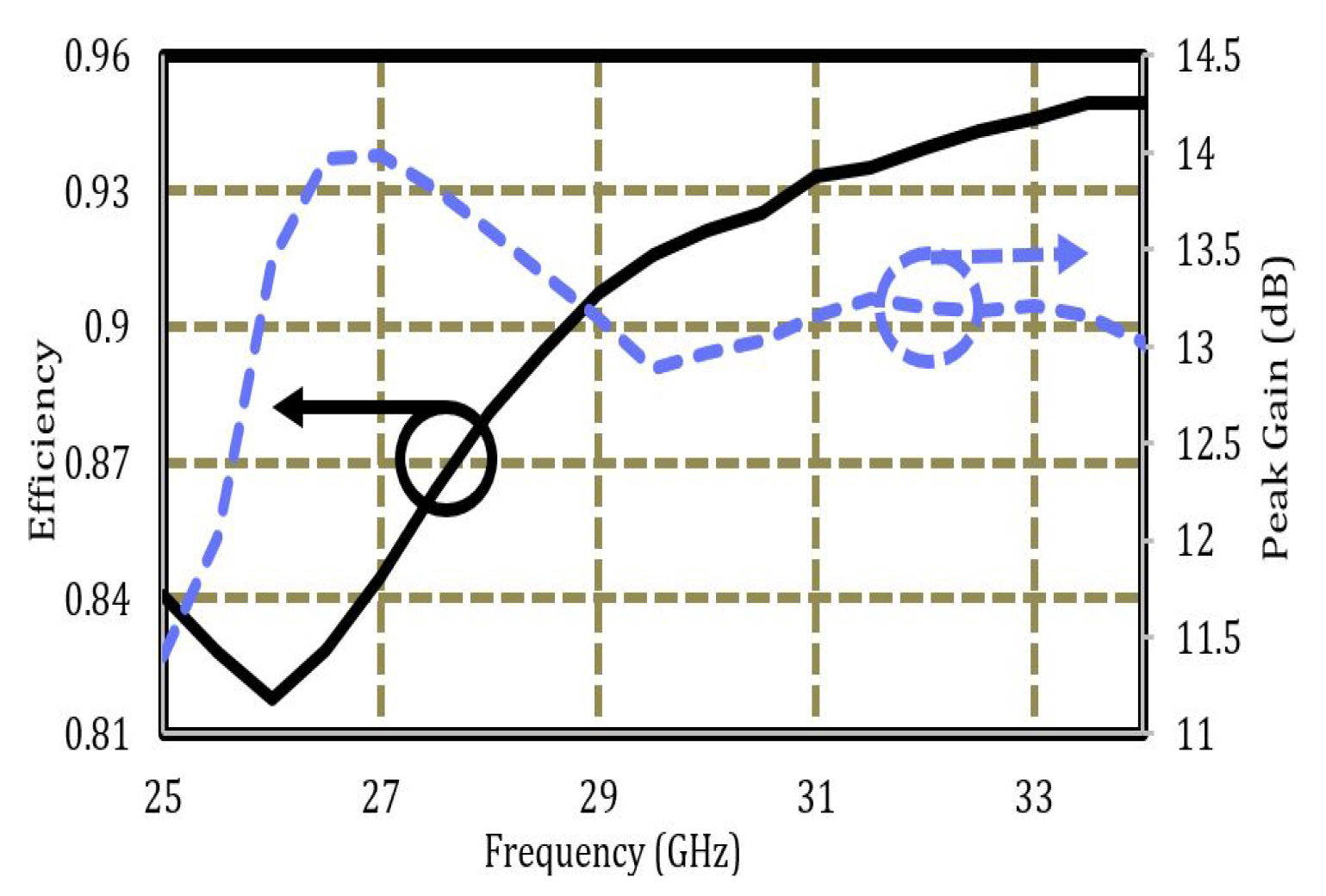
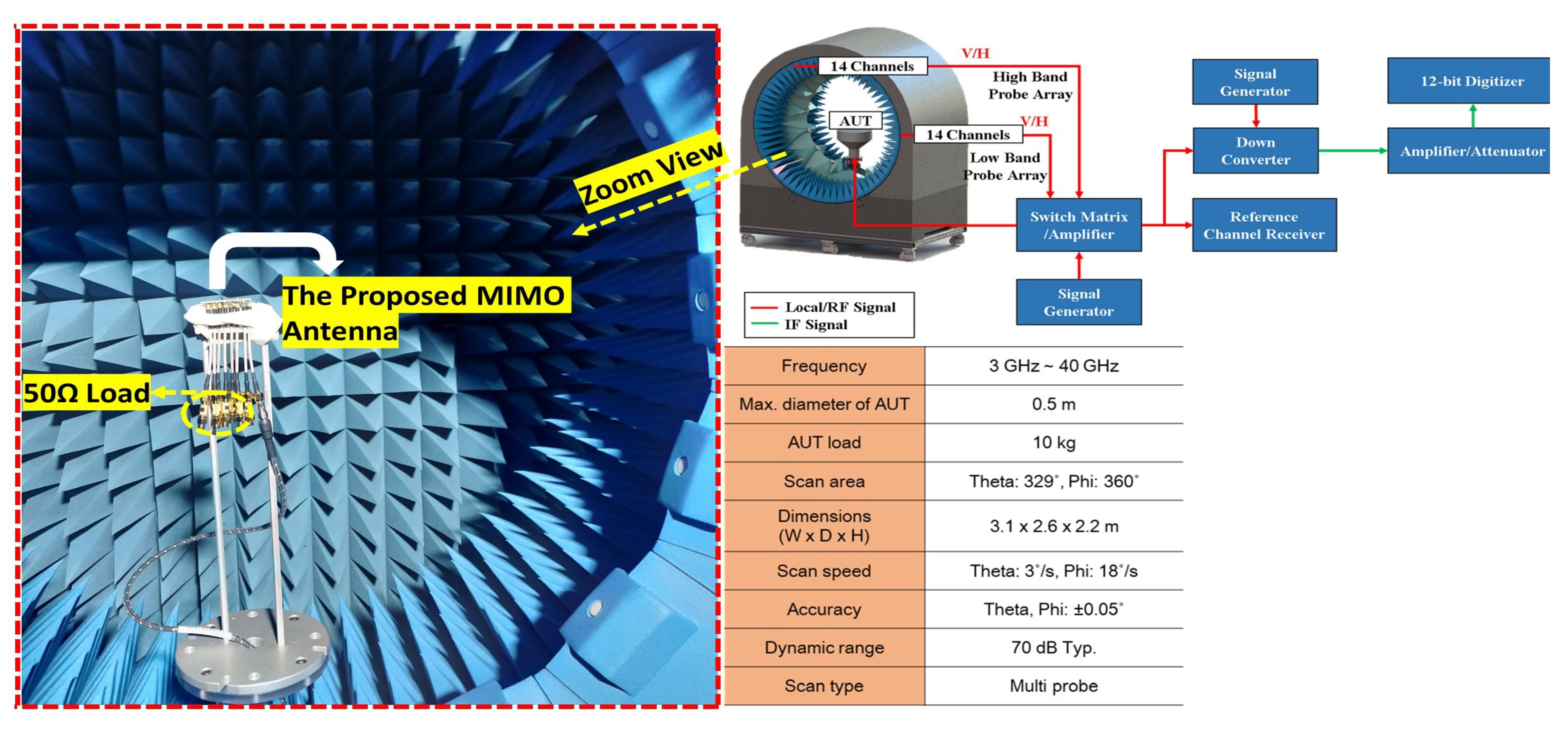

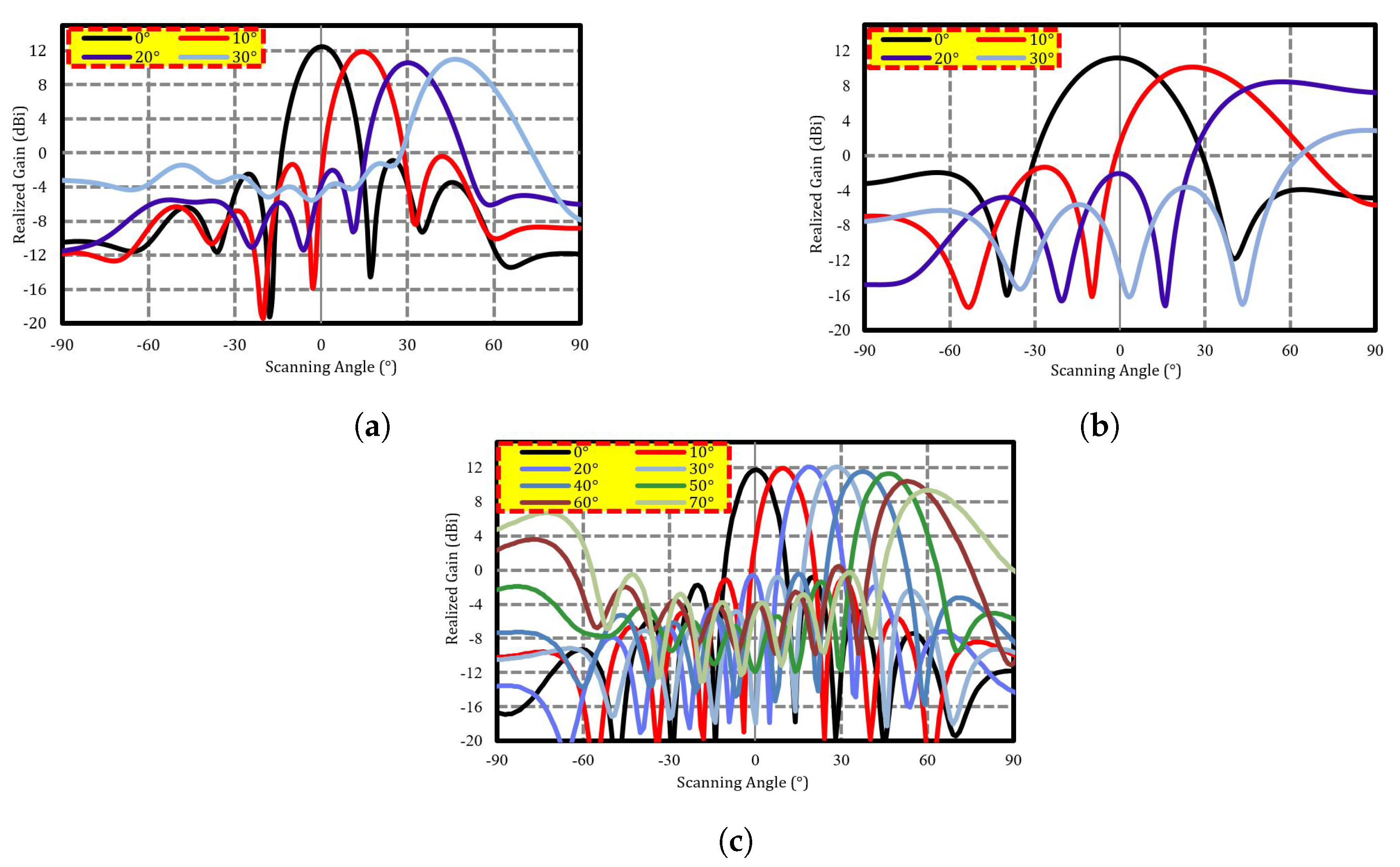
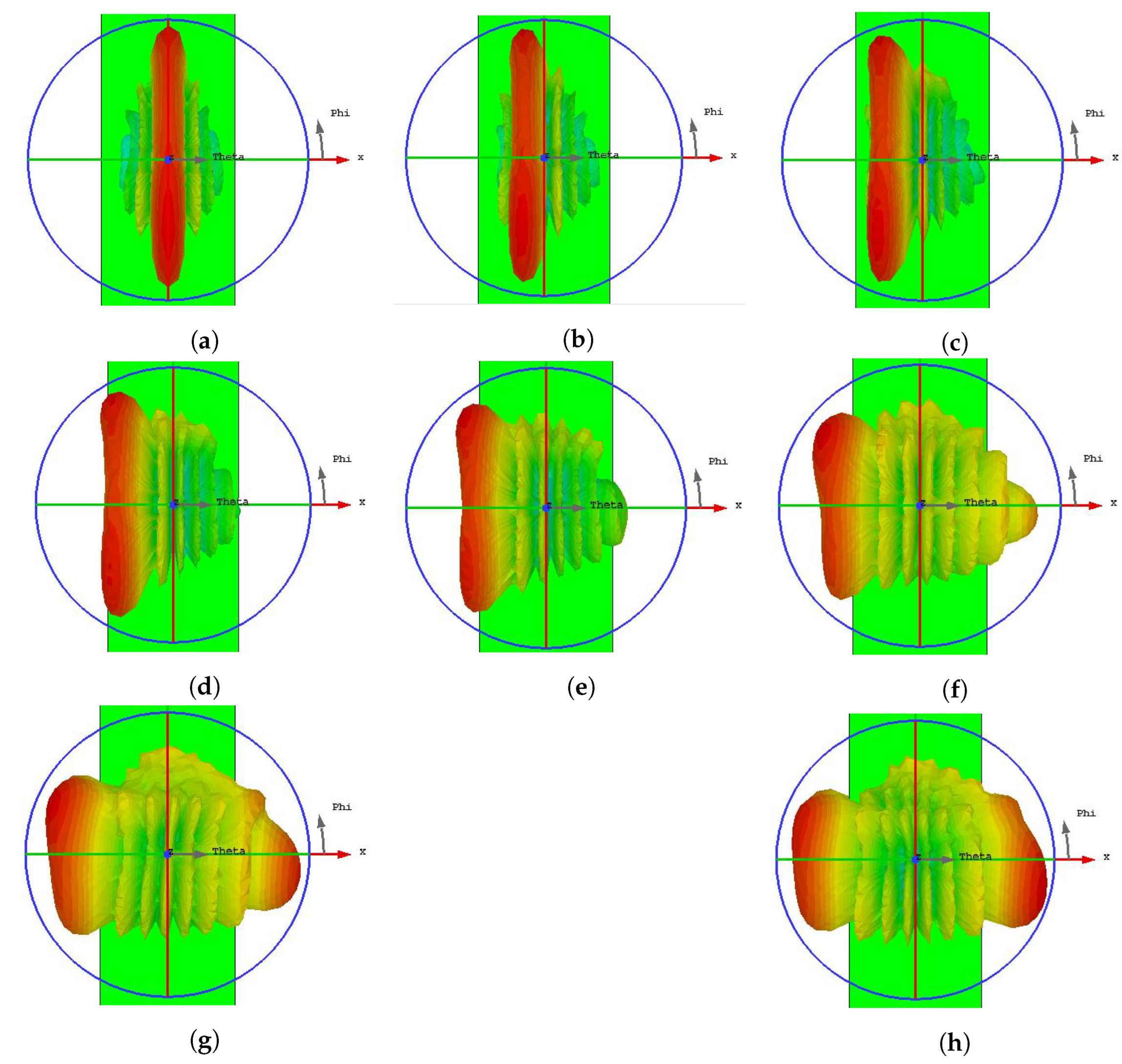
| Parameters | Dimension (mm) | Parameters | Dimensions (mm) |
|---|---|---|---|
| wg | 43.7 | Wm | 1.3 |
| lg | 118 | Lm | 1.2 |
| Ws | 5.3 | L1 | 1.2 |
| Le | 3.62 | W1 | 0.7 |
| We | 1.82 | g | 0.18 |
| Ls | 0.7 | ||
| Pointing Angle () | Phase Shift () | Pointing Angle () | Phase Shift () |
|---|---|---|---|
| 0 | 0 | 40 | 115.70 |
| 10 | 31.25 | 50 | 137.88 |
| 20 | 61.56 | 60 | 155.88 |
| 30 | 90 | 70 | 169.14 |
| Reference | Technique Used | Number of Elements | Center Frequency (GHz) | Realize Gain | Spacing between Elements | Isolation Improved | Maximum Scanning Angle |
|---|---|---|---|---|---|---|---|
| [16] | DGS | 2 | 9.2 | NA | 0.25 | 16 | NA |
| [17] | SRR | 2 | 5 | NA | 0.25 | 10 | NA |
| [22] | Waveguide Metamaterial | 2 | 3.5 | NA | 0.125 | 6 | NA |
| [23] | Slotted Meander-Line | 2 | 4.8 | NA | 0.38 | 16 | NA |
| [6] | SIW | 4 | 33 | 10.3 | NA | NA | 76° |
| [38] | Notches in Ground Plane | 8 | 28 | 14 | 0.5 | 15 | 60° |
| [39] | Multilevel Antenna | 4 | 3.5 | 9 | 0.32 | 15 | 42° |
| Proposed Design | Slots in the Patches | 8 | 29 | 11.7 | 0.5 | 14.7 | 70° |
Publisher’s Note: MDPI stays neutral with regard to jurisdictional claims in published maps and institutional affiliations. |
© 2022 by the authors. Licensee MDPI, Basel, Switzerland. This article is an open access article distributed under the terms and conditions of the Creative Commons Attribution (CC BY) license (https://creativecommons.org/licenses/by/4.0/).
Share and Cite
Ahmad, A.; Choi, D.-y. Compact Eight-Element MIMO Antenna with Reduced Mutual Coupling and Beam-Scanning Performance. Sensors 2022, 22, 8933. https://doi.org/10.3390/s22228933
Ahmad A, Choi D-y. Compact Eight-Element MIMO Antenna with Reduced Mutual Coupling and Beam-Scanning Performance. Sensors. 2022; 22(22):8933. https://doi.org/10.3390/s22228933
Chicago/Turabian StyleAhmad, Ashfaq, and Dong-you Choi. 2022. "Compact Eight-Element MIMO Antenna with Reduced Mutual Coupling and Beam-Scanning Performance" Sensors 22, no. 22: 8933. https://doi.org/10.3390/s22228933
APA StyleAhmad, A., & Choi, D.-y. (2022). Compact Eight-Element MIMO Antenna with Reduced Mutual Coupling and Beam-Scanning Performance. Sensors, 22(22), 8933. https://doi.org/10.3390/s22228933





